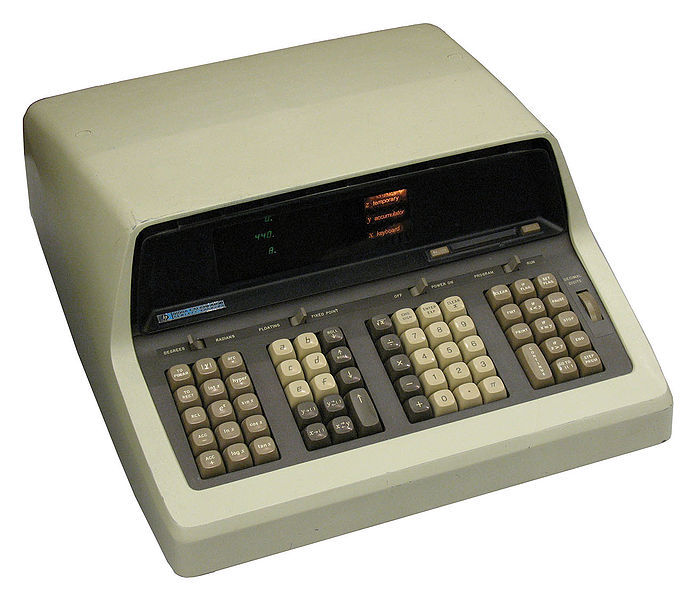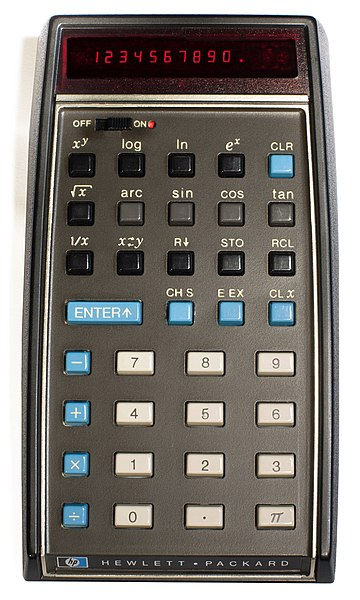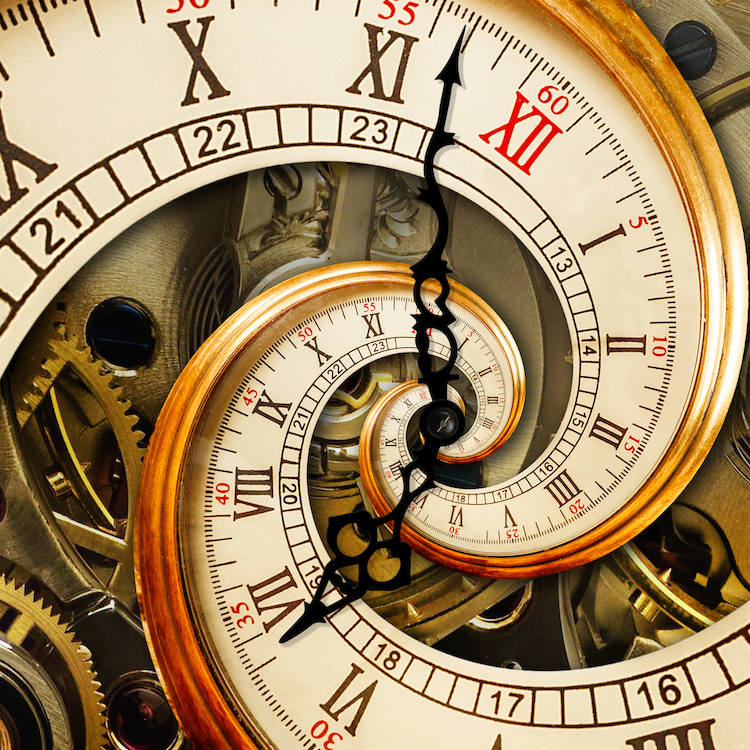Sadly, my friend Dave Cochran passed away on October 7. You’ve likely never heard of Dave Cochran, but if you ever owned a scientific calculator, you owe him, big time. Cochran was “Mr. Algorithm” at Hewlett-Packard starting with the earliest days of HP’s desktop scientific calculators in the late 1960s. He developed the arithmetic and trigonometric algorithms for HP’s first calculator, the HP 9100A desk calculator, using numerical calculation methods and approximations that had been around for hundreds of years. Then Bill Hewlett pestered him regularly for years until Cochran and his colleagues at HP Labs figured out how to pack the capabilities of the wall-powered HP 9100A into a battery-powered device that would fit in Hewlett’s shirt pocket.
Cochran didn’t start out as an algorithm guru. Like most engineers working at HP in the early days, he was an engineer’s engineer. His expertise in a wide range of engineering and scientific disciplines including thermodynamics, mechanics, logic design, computer architecture, optics, and semiconductors came through in the many groundbreaking products he helped to develop during his quarter of a century at HP. Cochran didn’t know everything, but he was never afraid to ask, “What’s that?” Once he had the answer, he was eager to use it.
Cochran’s destiny at HP was probably sealed at an early age when his family moved from San Francisco to Palo Alto. At the time, Cochran was in the second grade. Everyone living in Palo Alto, HP’s headquarters, knew about the company and its founders. Cochran enlisted in the US Navy during the Korean Conflict. The Navy trained him to be an electronics technician. Many people in the mid 20th century took this path to an engineering career and Cochran was no exception.
After he finished his enlistment in 1955, Cochran studied electrical engineering at Stanford University in Palo Alto. After his first year of study, he ran out of money. That’s when he became a test technician on the production line at HP. Within months, Cochran’s abilities were noticed and he was invited to work as a technician in “the lab,” where all new HP products were developed. In 1966, “the lab” would formally become “HP Labs,” the legendary Barney Oliver’s private ivory-tower domain.
Step by step, Cochran was becoming an HP engineer. His first design project as an engineer in the lab was to transistorize HP’s very first product, the Model 200 audio sine-wave oscillator, and “get the light bulb out of it.” Bill Hewlett had designed that oscillator circuit as an engineering student at Stanford. He’d used an incandescent light bulb’s positive temperature coefficient as a feedback element to coax an amplifier into oscillation and to generate pure sine waves.
During that project, which became the Model 204B, Cochran learned to design transistor circuits and lay out printed circuit boards. He used exponential spiral gears to transform a potentiometer’s linear resistance taper into the shape needed to make the transistorized RC oscillator’s operating frequency vary smoothly with a linear control dial on the oscillator’s front panel. Hewlett had used a very large variable capacitor in the original design, which was too big to fit into the planned enclosure for the new transistorized version. The spiral gears were an elegant mechanical solution to the problem. One of Cochran’s lab colleagues had suggested he try spiral gears and Cochran characteristically asked, “What’s that?” He’d never heard of exponential spiral gears. As soon as he understood the idea, he quickly used the concept to solve his problem. Cochran’s Model 204B audio oscillator appeared in HP’s 1961 product catalog. (Oddly, when Heathkit copied and transistorized Hewlett’s audio sine-wave oscillator circuit, it kept the light bulb in the feedback path. I know this because I built one in high school.)
Cochran’s next project was a partnership with another lab engineer, Chuck Near. Their assignment was to design a replacement for the Model 405BR, an early HP digital voltmeter that wasn’t very successful against competitors. The replacement would be called the HP 3440A digital voltmeter and it would become a smash hit for the company. But first, Cochran and Near had to figure out a way to implement the relatively new concept of dual-slope integration, the central technique needed to accurately digitize a voltage reading. This technique uses an analog integrator circuit that first ramps up from zero at a rate proportional to the input voltage sample and then ramps back down to zero at a rate determined by a reference voltage inside of the voltmeter. The measured time taken to ramp back down to zero provides the voltage reading.
The critical part of the integrator’s design was making sure that the two ramps would track over the voltmeter’s full operating temperature range. The critical circuitry involved a pair of thermally matched diodes. Using discrete diodes produced terrible results, so Cochran asked a colleague in HP’s solid-state lab if it were possible to manufacture two diodes on the same semiconductor die. The answer was yes, and the HP 3440A voltmeter would incorporate HP’s first “integrated circuit,” even if it was just two matched diodes. Cochran attacked non-electronic problems with materials science and system-level heat dissipation during the HP 3440A project with his usual curiosity and dogged determination. He’d soon need those skills because HP was about to enter the calculator business, and he had a central role to play.
In the summer of 1965, two technology pilgrimages brought similar offerings to Barney Oliver’s now-famous HP Labs. The offerings were prototype electronic calculators. Malcolm Macmillian, a mathematician, brought Athena, with advanced trigonometric capabilities and a very unreliable hardware design. Athena’s trigonometric capabilities were based on the CORDIC algorithm developed by Macmillan’s partner Jack Volder in 1959. Tom Osborne brought his Green Machine, an extremely elegant bit of logic design that performed floating-point arithmetic but did not compute trigonometric functions.
Oliver was intrigued enough to borrow the machines for 30 days so some of his lab engineers could further study the machines and see if they might result in a product that would interest HP’s primary market: engineers. He explained the evaluation project to about 20 of the engineers on his team, including Cochran. Cochran asked, “What’s an algorithm?” He got the same answer that everyone in the lab got when they asked Barney Oliver that sort of question: “You’re going to find out.”
Cochran flew down to Southern California and discussed CORDIC algorithms with Jack Volder, who referred Cochran to the original papers by IBM’s J.E. Meggitt. That’s where Volder had found the pseudo division and pseudo multiplication algorithms he’d used to create the Athena calculator. As usual, Cochran absorbed it all and started to synthesize an architecture for an HP calculator in his mind. At the end of the 30-day evaluation, HP cut deals with Macmillan and Osborne and hired them as consultants. It also put Cochran on the development team. He would be the algorithm guy. The team would develop HP’s first desktop scientific calculator, the HP 9100A.
Based on his analysis of Volder’s mathematical algorithms, Cochran determined how many digits the calculator needed to hold for the desired precision, how many registers he’d need, and the operation times required – therefore the clock speed for the calculator’s circuitry. Others on the team added requirements for scanning the calculator’s keyboard and running the display. Osborne developed a 64-bit-wide, microprogrammed state machine to perform the calculations and drive the keyboard and display. The state machine used no integrated circuits, only discrete transistors.
The state machine used a 32-Kbit (512 words, 64 bits per word) ROM made from a 15-layer printed circuit board, because that sort of density was beyond the capabilities of any semiconductor process technology available in the mid-1960s. Cochran’s former team member Chuck Near had designed the ROM. The state machine expanded 6-bit fields within the 64-bit ROM words using a braided magnetic rope memory borrowed from missile-guidance technology for the microcode ROM. The microcode was literally woven into this ROM. A small, 2208-bit, magnetic core memory served as the machine’s RAM. Semiconductor RAM of sufficient capacity was still out of reach.
Because this was a ROM-driven state machine, not quite a processor, Cochran programmed his algorithms into the state-machine ROM using graphical flowcharting. There was no assembly language. He used Volder’s CORDIC algorithms to calculate trig functions; Meggitt’s algorithms for pseudo multiplication and pseudo division to calculate logarithms, exponentials, and square root functions; and well-known math identities to compute hyperbolic functions.
The whole machine ran at 1.21 MHz. Because it was a highly parallel machine, thanks to the 64-bit state machine, the HP 9100A could add or subtract two floating-point numbers in 2 milliseconds, multiply two numbers in 12 milliseconds, and perform trig computations in 280 milliseconds. In addition, the state machine’s parallelism allowed the calculator to perform several tasks simultaneously. While Cochran’s code was performing mathematical computations using one portion of the state machine, other portions were busy refreshing the 3-line CRT display and scanning the keyboard. The HP 9100A was ten times faster than competing electronic calculators.
HP introduced the HP 9100A calculator privately to a selected group of customers at the IEEE Electro show held in New York during March 1968 and formally announced the HP 9100 to the world in the September 1968 issue of the HP Journal. It was a huge success. During the Electro show, Bill Hewlett gave An Wang, founder and head of Wang Labs, a private showing of the HP 9100A because it was going to compete with Wang’s products and Hewlett was acting like a gentleman. After HP introduced the HP 9100A, the company’s legal department received a letter from Wang saying that HP had infringed on their patents. Cochran just sent a note back with references to the logarithm-based algorithms he’d used, which were published by the British mathematician Henry Briggs in the early 1600s. Cochran’s note said, “It looks like prior art to me.” That was the last HP heard from Wang.

HP introduced the 9100A desktop scientific calculator in 1968.
Image credit: Michael Holley, Wikimedia Commons
As soon as the HP 9100A hit the market, Bill Hewlett started pestering his engineers, including Cochran, to develop a version of the machine that would fit in his shirt pocket. That sort of capability was simply beyond the state of the art in 1968. However, the big boss wanted a pocket scientific calculator, so Cochran kept an eye on the advancing art in semiconductors. In September 1970, he saw a calculator chip design based on shift registers that Fairchild was manufacturing for Sweda to build cash registers and point-of-sale terminals. Cochran saw, because he was ready to see, how this technology could be used to put a scientific calculator in Bill Hewlett’s pocket.
Paul Stoft, then an HP Labs section head, Cochran, and Cochran’s boss Tom Whitney created a plan to develop the pocket scientific calculator and presented it to Hewlett. He asked what it would cost. When he heard the price, one million dollars, he was put off and wouldn’t authorize the project. Stoft authorized the initial work anyway under his existing lab budget and put a dozen or so of his engineers on the project. The result was the HP 35 pocket scientific calculator. Once again, Cochran and his algorithms sat at the heart of the product. HP launched the HP 35 in early 1972. The initial batch of 100,000 chip sets lasted two months instead of the most optimistic projections, which said the first batch would last six months or more. The HP 35 was so popular that HP’s salespeople started neglecting the company’s other products. The HP 35 put HP into the calculator business, and into consumer products.

HP introduced the Model 35, the world’s first pocket scientific calculator, in 1972. Image credit: Mister rf, Wikimedia Commons
Cochran worked on several more HP calculators – notably the HP 45 and 65 – but he left HP in 1981. The company was emphasizing marketing and de-emphasizing engineering under the new CEO John Young. Cochran no longer felt like he fit in. He said goodbye to a retired Dave Packard personally, who agreed with Cochran and apologized. Cochran eventually jumped into the disk drive business.
I’d never met Cochran at HP although our jobs there overlapped by five years. I met him many years later, long after we’d both left HP. The intervening years had not dimmed his fond memories of the engineering company he’d joined in 1956. It had been quite a ride, for both of us. I interviewed Cochran in 2007 and recorded a video. It’s posted on YouTube. Although we met only briefly, I immediately liked Dave Cochran. He was clearly a guy who loved life and lived accordingly. He was an engineer’s engineer. I hope this article has captured some of his contributions. Please join me in celebrating his life.
References
https://www.hpmemoryproject.org/timeline/dave_cochran/a_quarter_century_at_hp_00.htm
https://archive.computerhistory.org/resources/access/text/2013/05/102743058-05-01-acc.pdf






Thanks for this article! Bill Hewlett used the light bulb’s positive temperature coefficient to regulate the oscillation amplitude without distorting the sinewave, by using the light bulb as an analog memristor. See U.S. Patent 02,268,872 for details.
Not really like a memristor. It has no permanant or semi permanant memory. More like a PTC thermistor or surge limiter.
The light bulb does have a short-term memory, as the filament’s resistance depends upon the average RMS sinewave power over a fraction of a second, rather than upon the instantaneous power. This averaging is why the light bulb can regulate the oscillation amplitude without distorting the sinewave.
Thanks for this remembrance Steve — it’s great to hear about the people behind the technology in this way.
“not quite a processor, Cochran programmed his algorithms into the state-machine ROM using graphical flowcharting.” Although a flowchart is not a state machine, it appears that Dave Cochran was on the cusp of a new computational programming paradigm modeled as propagating parallel asynchronous flowcharts now called a Flowpro Machine. I wish I had met the man.
Great story! Thank you.
Great story, Steve. Dave was a lovely guy. I got to know him a bit at the Computer History Museum, where we have a 55-page oral history (which you reference) and a Case Study on the HP-35, written by Dave, available here: https://www.computerhistory.org/collections/catalog/102746048.
Summary: “The HP-35 was the epitome of a revolutionary mousetrap. Hand-held four function calculators were already on the market. Few could imagine a machine with scientific calculation capability that would fit in your shirt pocket, but many could readily see the use and the need started growing in their minds.
Developed by Hewlett-Packard Company in Palo Alto, California at 1501 Page Mill Road and introduced in 1972, the HP-35 was the first full-function, shirt-pocket-sized, scientific calculator. This invention revolutionized the profession by allowing the engineer to make almost instantaneous, extremely accurate scientific calculations, at home, office or in the field.
The HP-35 was the innovative culmination of mechanical design, state-of-the-art technology, algorithm development and application; all unique at that time.”
Thanks for keeping his name alive… the HP-35 ‘electronic slide rule’ is one of the 20th century’s revolutionary inventions.
–Dag Spicer.